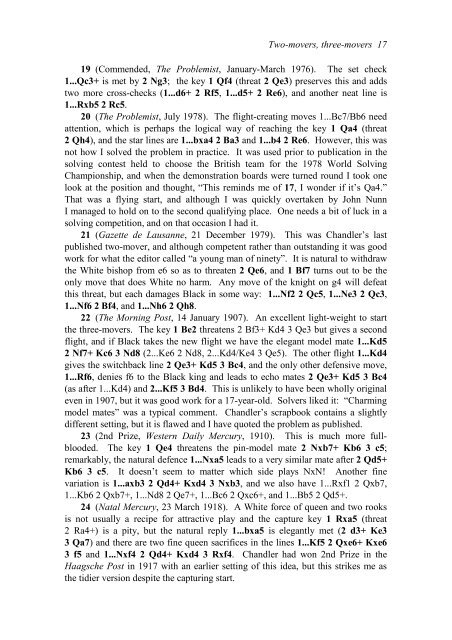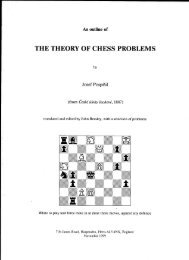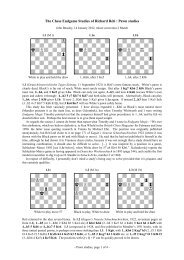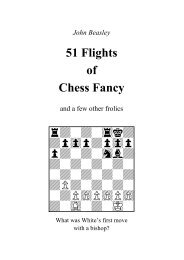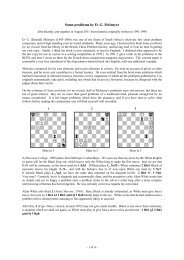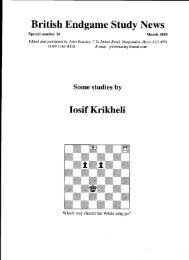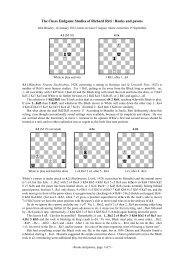A tribute to G. W. Chandler - John and Sue Beasley
A tribute to G. W. Chandler - John and Sue Beasley
A tribute to G. W. Chandler - John and Sue Beasley
Create successful ePaper yourself
Turn your PDF publications into a flip-book with our unique Google optimized e-Paper software.
Two-movers, three-movers 17<br />
19 (Commended, The Problemist, January-March 1976). The set check<br />
1...Qc3+ is met by 2 Ng3; the key 1 Qf4 (threat 2 Qe3) preserves this <strong>and</strong> adds<br />
two more cross-checks (1...d6+ 2 Rf5, 1...d5+ 2 Re6), <strong>and</strong> another neat line is<br />
1...Rxb5 2 Rc5.<br />
20 (The Problemist, July 1978). The flight-creating moves 1...Bc7/Bb6 need<br />
attention, which is perhaps the logical way of reaching the key 1 Qa4 (threat<br />
2 Qh4), <strong>and</strong> the star lines are 1...bxa4 2 Ba3 <strong>and</strong> 1...b4 2 Re6. However, this was<br />
not how I solved the problem in practice. It was used prior <strong>to</strong> publication in the<br />
solving contest held <strong>to</strong> choose the British team for the 1978 World Solving<br />
Championship, <strong>and</strong> when the demonstration boards were turned round I <strong>to</strong>ok one<br />
look at the position <strong>and</strong> thought, “This reminds me of 17, I wonder if it’s Qa4.”<br />
That was a flying start, <strong>and</strong> although I was quickly overtaken by <strong>John</strong> Nunn<br />
I managed <strong>to</strong> hold on <strong>to</strong> the second qualifying place. One needs a bit of luck in a<br />
solving competition, <strong>and</strong> on that occasion I had it.<br />
21 (Gazette de Lausanne, 21 December 1979). This was <strong>Ch<strong>and</strong>ler</strong>’s last<br />
published two-mover, <strong>and</strong> although competent rather than outst<strong>and</strong>ing it was good<br />
work for what the edi<strong>to</strong>r called “a young man of ninety”. It is natural <strong>to</strong> withdraw<br />
the White bishop from e6 so as <strong>to</strong> threaten 2 Qe6, <strong>and</strong> 1 Bf7 turns out <strong>to</strong> be the<br />
only move that does White no harm. Any move of the knight on g4 will defeat<br />
this threat, but each damages Black in some way: 1...Nf2 2 Qc5, 1...Ne3 2 Qc3,<br />
1...Nf6 2 Bf4, <strong>and</strong> 1...Nh6 2 Qh8.<br />
22 (The Morning Post, 14 January 1907). An excellent light-weight <strong>to</strong> start<br />
the three-movers. The key 1 Be2 threatens 2 Bf3+ Kd4 3 Qe3 but gives a second<br />
flight, <strong>and</strong> if Black takes the new flight we have the elegant model mate 1...Kd5<br />
2 Nf7+ Kc6 3 Nd8 (2...Ke6 2 Nd8, 2...Kd4/Ke4 3 Qe5). The other flight 1...Kd4<br />
gives the switchback line 2 Qe3+ Kd5 3 Bc4, <strong>and</strong> the only other defensive move,<br />
1...Rf6, denies f6 <strong>to</strong> the Black king <strong>and</strong> leads <strong>to</strong> echo mates 2 Qe3+ Kd5 3 Bc4<br />
(as after 1...Kd4) <strong>and</strong> 2...Kf5 3 Bd4. This is unlikely <strong>to</strong> have been wholly original<br />
even in 1907, but it was good work for a 17-year-old. Solvers liked it: “Charming<br />
model mates” was a typical comment. <strong>Ch<strong>and</strong>ler</strong>’s scrapbook contains a slightly<br />
different setting, but it is flawed <strong>and</strong> I have quoted the problem as published.<br />
23 (2nd Prize, Western Daily Mercury, 1910). This is much more fullblooded.<br />
The key 1 Qe4 threatens the pin-model mate 2 Nxb7+ Kb6 3 c5;<br />
remarkably, the natural defence 1...Nxa5 leads <strong>to</strong> a very similar mate after 2 Qd5+<br />
Kb6 3 c5. It doesn’t seem <strong>to</strong> matter which side plays NxN! Another fine<br />
variation is 1...axb3 2 Qd4+ Kxd4 3 Nxb3, <strong>and</strong> we also have 1...Rxf1 2 Qxb7,<br />
1...Kb6 2 Qxb7+, 1...Nd8 2 Qe7+, 1...Bc6 2 Qxc6+, <strong>and</strong> 1...Bb5 2 Qd5+.<br />
24 (Natal Mercury, 23 March 1918). A White force of queen <strong>and</strong> two rooks<br />
is not usually a recipe for attractive play <strong>and</strong> the capture key 1 Rxa5 (threat<br />
2 Ra4+) is a pity, but the natural reply 1...bxa5 is elegantly met (2 d3+ Ke3<br />
3 Qa7) <strong>and</strong> there are two fine queen sacrifices in the lines 1...Kf5 2 Qxe6+ Kxe6<br />
3 f5 <strong>and</strong> 1...Nxf4 2 Qd4+ Kxd4 3 Rxf4. <strong>Ch<strong>and</strong>ler</strong> had won 2nd Prize in the<br />
Haagsche Post in 1917 with an earlier setting of this idea, but this strikes me as<br />
the tidier version despite the capturing start.


